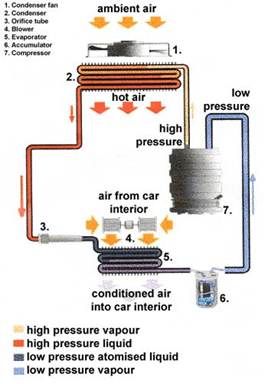It keeps you cool in the heat of Summer and it keeps you toasty in Winter but have you ever wondered exactly how car air conditioning works? Just in case you have, let us explain it to you. Don’t worry, you don’t need to be an Auto Electrician to understand it.
All air conditioners work the same, they all condition the air by cooling it down and reducing the humidity. It is pretty cool (pun intended) to think that your car’s system works the same way as your fridge and your air conditioner at home. As beautiful as it is on the Sunshine Coast we all reach for that A/C button in the Summer heat.
By understanding how your car air conditioning works you will realise the importance of regular maintenance which will, in turn, save you money in the long run for expensive repairs. You may not realise it but fuel consumption is also affected. Maintaining your air conditioning system with your local Auto Electrician will save you money on fuel.
Your air conditioner works on four main principles – Evaporation, Condensation, Compression and Expansion by cooling. Let me explain each one of these principles so we can put them all together…
Evaporation:
Evaporation removes heat, this is why we sweat, and as the sweat evaporates we cool down. This is the same as if you put any sort of spirit on your skin, you can feel the coolness as it evaporates.
Condensation:
We have all seen condensation in action, just take a hot shower and watch the steam condense on the cold glass of the shower screen. Also here on the Sunshine Coast, you can see the sea water condensing on any steel surfaces on a cool morning. Once the sun comes up the water evaporates away.
Compression:
When you compress any gas it causes heat, you will notice when you pump up a bike tire the end of the pump and the valve gets hot. This is caused by the molecules getting squished together. The closer they get the more heat is generated until eventually, you get a liquid.
So basically these principles all occur in your system in different components all joined together by hoses and tubing. The components are Compressor, Dryer, Condenser, Evaporator and TX Valve.
The fluid that passes through the system is called a refrigerant. The refrigerant can evaporate at a low temperature and then condense again at a higher pressure. All cars after 1996 use a non-CFC fluid called R-134A which is not as bad for the environment as the previous gas but is still a major greenhouse gas. This is why a leaking system MUST never be just re-gassed to find the leak.
A qualified Auto Electrician will find the leak using other environmentally friendly methods. Here at Accelerate Mobile Auto Electrics in Maroochydore, we use various environmentally friendly methods including Nitrogen Pressure Testing.

Compressor:
The compressor is the pump of the air conditioning system. It is powered by a belt connected to the crankshaft of the engine. When you push your button, the compressor pumps refrigerant vapour under high pressure to the condenser.
Condenser:
The condenser is just in front of your radiator and it looks a lot like your radiator. It is used to change the high-pressure refrigerant vapour to a liquid. The vapour is condensed to a liquid because of the high pressure that is driving it in by the compressor. This then generates a lot of heat.
This heat is then in turn dissipated from the condenser by air flowing through the condenser on the outside that is pushed by your thermo fan. Here on the Sunshine Coast, the condenser can suffer from corrosion due to the salt in the air. At Accelerate Mobile Auto Electrics we have developed a treatment method that will help keep the corrosion at bay.
Accumulator:
The liquid refrigerant passes through the receiver-dryer. This is a small filter for the liquid refrigerant. It absorbs any moisture that may have leaked into the refrigerant. Moisture in the system is the enemy, it causes failures and expense, with ice crystals causing blockages and mechanical damage.
At Accelerate Mobile Auto Electrics on the Sunshine Coast, we carry a large range of accumulators in stock so that we can service your air conditioner immediately.
Expansion Valve or TX Valve:
The high-pressure refrigerant flows from the Accumulator to the TX valve. This valve depressurizes the liquid refrigerant so that it can expand and become refrigerant vapour in the evaporator. The TX valve is an amazing little contraption, a lot of people underestimate the importance of your TX valve.

Evaporator:
The evaporator has tubes and fins mounted inside the passenger compartment behind the dash. When the cold low-pressure refrigerant flows from the evaporator, it vaporises and absorbs heat from the air in the passenger compartment.
The blower fan which is located inside the passenger compartment pushes air across the outside of the evaporator. This pushes the cold air into the car. On the ‘air-side’ of the evaporator, the moisture in the air is reduced, and the ‘condensation’ is collected and drained away.
Compressor:
The compressor then sucks the low-pressure refrigerant vapour to start another refrigeration cycle. The refrigeration cycle then runs continuously and is regulated by the setting of the expansion valve.
I hope the whole process seems simple when explained like that. All air conditioning systems work the same, though components do vary slightly between car manufacturers.
We hope that explains a little as to how your car air conditioning works. If you want it explained a little more in depth then roll up your sleeves and we can show you the components in your car next time you bring your car in for a check or service at Accelerate Auto Electrics.
Ever wondered what all the buttons on your air-conditioner do? Check out our video…
